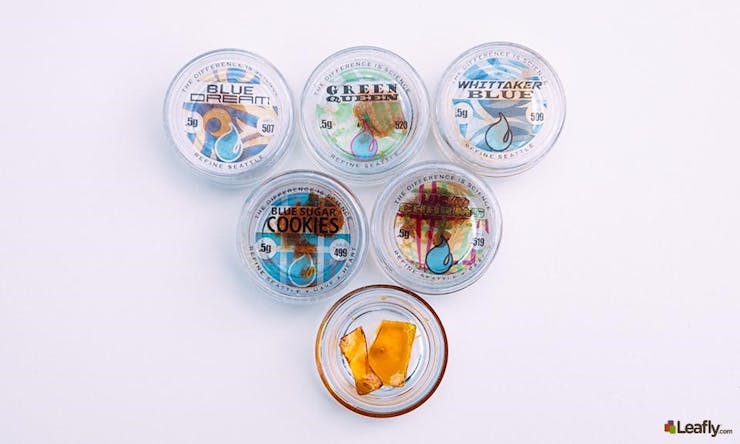Last week, we recruited the help of X-Tracted Labs to debunk popular myths about what good hash oil looks like. In this installment of dabbing and hash oil myths, we meet again with X-Tracted’s co-founder Ryan Abernathy, who explains why quality oil provides much more than a high.
Since its rapid rise in the medical marijuana market, BHO (butane hash oil) has come under fire for being a dangerous and non-medicinal substance used solely to achieve new psychoactive heights. Now some states are even considering bills that would ban the sale of dabs altogether.
Ryan introduced us to X-Tracted’s top-shelf brand Refine Seattle, a league of concentrates that truly captures the therapeutic properties of the cannabis plant. In collaboration with Steep Hill Labs, X-Tracted has developed a scientifically informed process that seizes both purity and potency. But what exactly coinstitutes “medical-grade” hash oil?
Myth: Butane Hash Oil Can’t Be Healthy or Medicinal

X-Tracted Labs uses vacuum ovens to purge residual solvents at lower temperatures, whioh better preserve cannabinoids and terpenes.
Many people who are passionate about hash oil understand that there is in fact medical value in pure, potent concentrates. Not only do they eliminate combustible plant material, high quality oils will be rich in cannabinoids and terpenes, or cannabis compounds that deliver a diversity of medical effects too numerous to list here. Unfortunately, hazardous home extractions and substandard BHO have shifted the political spotlight away from processors with safe extraction practices and clean products.
Ryan explained that certain hydrocarbons like those used at X-Tracted Labs have certified purity and predictable molecular behavior, and have also been approved for human consumption. On the other hand, canned butane commonly used in amateur extractions is more of a mystery bag of gases and carcinogens.
“They typically have 30% N-butane, 30% iso-butane, 20% propane, and then a bunch of random other stuff, up to 40 or 50 gases,” he told us. “It’s not food grade, so there’s no regulation.”
Different gases have different evaporation temperatures, and if you’re not sure what those gases are, it’s very likely that impurities will not be fully purged. For this reason, consumers should demand lab tested products until regulation can hold producers accountable for quality and purity.
Myth: It’s All About the THC

This myth is relevant to patients, adult consumers, and processors alike: there is much more to high-grade hash oil than their THC content.
“The most important factor to us is a low parts-per-million of residual solvent,” Ryan said. “Secondary from that, we really like terpene preservation. I’m a very firm believer that pure THC doesn’t interact with your body in the same way.”
Terpenes, or the aromatic oils secreted by the plant’s trichomes, provide cannabis and its extracts with distinctive smells and flavors. Not only that, terpenes modulate other compounds in cannabis (eg., THC and CBD) for a more therapeutic effect. If extracted properly, the aroma of hash oil should be somewhat redolent of the flower used to make it.
Even with this exciting new discovery in cannabis research, dispensaries and consumers are still largely concerned with that THC figure. “It makes no sense to me,” Ryan said. “No normal user can’t tell the difference between 50% THC and 75% THC.”
In fact, the difference between THC-focused oils and those with a rich diversity of compounds is often detectable in the flavor, psychoactivity, and medical efficacy. In a phenomenon known as the “entourage effect,” all components of the cannabis plant work together synergistically, and trust us, this makes for a more impressive product than those that only reach for THC’s ceiling.
Myth: Quality Begins and Ends in the Extraction Lab

While the use of pure solvents and medical-grade extraction equipment are cornerstones of quality concentrates, the full story extends all the way back to the garden. Growers make up step one of the big picture process, which is why X-Tracted rigidly screens incoming product.
“We call it ‘training’ growers,” Ryan said. “We make sure they understand that things like topical treatments, neem oil, pesticides, those will all end up in the end product. And then there’s how you handle your trim: if you’re just trimming your product, throwing it on the floor, sweeping it up and throwing it in a lemon-scented trash bag, that’s not going to make good hash oil.”
It is imperative that dispensaries understand what factors are involved in the oil-making process and evaluate their suppliers and products with strict standards. Until accountability is required across the board, it is up to consumers to educate themselves and others about hash oil, its production, and its medical properties. As concentrates become an important consideration in emerging cannabis laws, it is our duty as advocates to support responsible extraction practices that propel the industry forward while discouraging those that are holding it back.





